Mechanical keyboard review - UHK v1, Mistel BAROCCO MD770, Drop Alt Captain
- The search for the best programmer’s keyboard
- Keyboard companions - trackpad and mouse
- Ergonomic mechanical keyboard - UHK v1
- Remapping keys and configuring keyboards
- Ergonomic mechanical keyboard - Mistel BAROCCO MD770
- Non-ergonomic mechanical keyboard - Drop Alt Captain
The search for the best programmer’s keyboard #
I type a lot, every day. And I need a keyboard that can help me take care of my hands and body, so as not to wear anything them out, or cause needless fatigue or repetitive stress injuries.
I used to use the Kinesis Advantage keyboard for almost a decade from 2000 to 2010. After that I switched to the Kinesis Freestyle and finally to Kinesis Freestyle Edge mechanical RGB backlit keyboard after that came out. So I’ve had a long history with Kinesis 😀.
All that came to an end when I embarked on the search for a more programmer friendly ergonomic keyboard. Programmer friendly in the sense that I wanted to remap my keys to be whatever I choose, whether that means swapping keys for other keys, or creating macros, or even working with multiple keyboard layers.
You can find an awesome list of split keyboards here.
The first one that I tried was the Ergodox EZ keyboard, which I didn’t like at all. The build quality was not that great and the keyboard layout didn’t make much sense to me. And I didn’t like the software to configure the keyboard either. I liked the ergonomics of the Kinesis Freestyle Edge much better, even without the ability to customize it much. And the build quality of the Freestyle Edge RGB was on par with the Ergodox EZ, nothing great, but not bad either.
Keyboard companions - trackpad and mouse #
Before getting into the keyboard review, I wanted to cover the other input devices I use with them. I have two input devices that I use with these keyboards. This keyboard does support mouse movement, but this is not so good for complex mouse movements (great for short movements).
- Logitech MX3 Master - This is the best mouse that I have ever used. Everything about it is amazing. Sadly on Linux customization options are limited, but you can do a lot on Windows or macOS w/ customizing the mouse itself.
- Apple Magic Trackpad 2 - Since the UHK has a big gap in the middle, I usually have a trackpad there so that I don’t have to reach for the mouse to for scrolling a page or some small movements to click on a UI element on screen. When using drawing apps, then I definitely use the mouse. But this can be cumbersome for mundane operations like clicking on buttons in IDEA dialog boxes, or just browser operation (I try to use Vimium to minimize mouse / trackpad interaction in general). You might also try this trackpad.
Ergonomic mechanical keyboard - UHK v1 #
Then I found out about the Ultimate Hacking Keyboard. I thought that was quite a claim in the name when I first heard of it. So I ordered my first one with very high expectations. I ordered it with the MX Brown switches and the fantastic wrist wrests (made out of solid wood). And I am happy to report that the name accurately matches the product and my expectations where blown away! I am a fan for life!
Then I ordered another one, with the ISO keyboard layout instead of the US 😀.
Then I pre-ordered the UHK v2 RGB keyboard, and am now impatiently waiting for the keyboard to come out, along with the modules. As soon as that happens (expected to start shipping in March 2021) I will be sure to post a new review (of v2 and the new modules).
Pros #
Where to begin about all that is right with this keyboard. Just about everything. The build quality is outstanding! I ordered the wooden palm rests, which are not only solid and heavy, but look and feel great. Everything about this keyboard exudes craftsmanship and quality. There is no planned obsolescence to be found anywhere in this keyboard.
Not only is the physical keyboard itself magnificent, but the UHK Agent software that you use to program it is just fantastic! It has a really easy to use and powerful UI. The electron based app also supports Dark Theme 😀. It is just painless to use, and makes it a joy to reprogram the keyboard to whatever you desire. And you can do firmware updates with ease. And it works on any platform.
Here’s an example of how amazing Agent and the UHK are. The Support staff at UHK are awesome as well, and they helped me to figure this out! By default if you double tap the Fn or Mod keys, they lock. And you are in that layer until you unlock (by pressing the key that got you into that layer in the first place). This can be really annoying when accidentally double pressing these layer keys. Agent simply allows you to change this behavior in the following ways:
- You can simply tell Agent to disable the Mod key from sticking if you double press it.
- You can also tell Agent to toggle everytime you press.
So you can make it to whatever you like! Here’s a video to illustrate the awesomeness that is UHK and Agent!
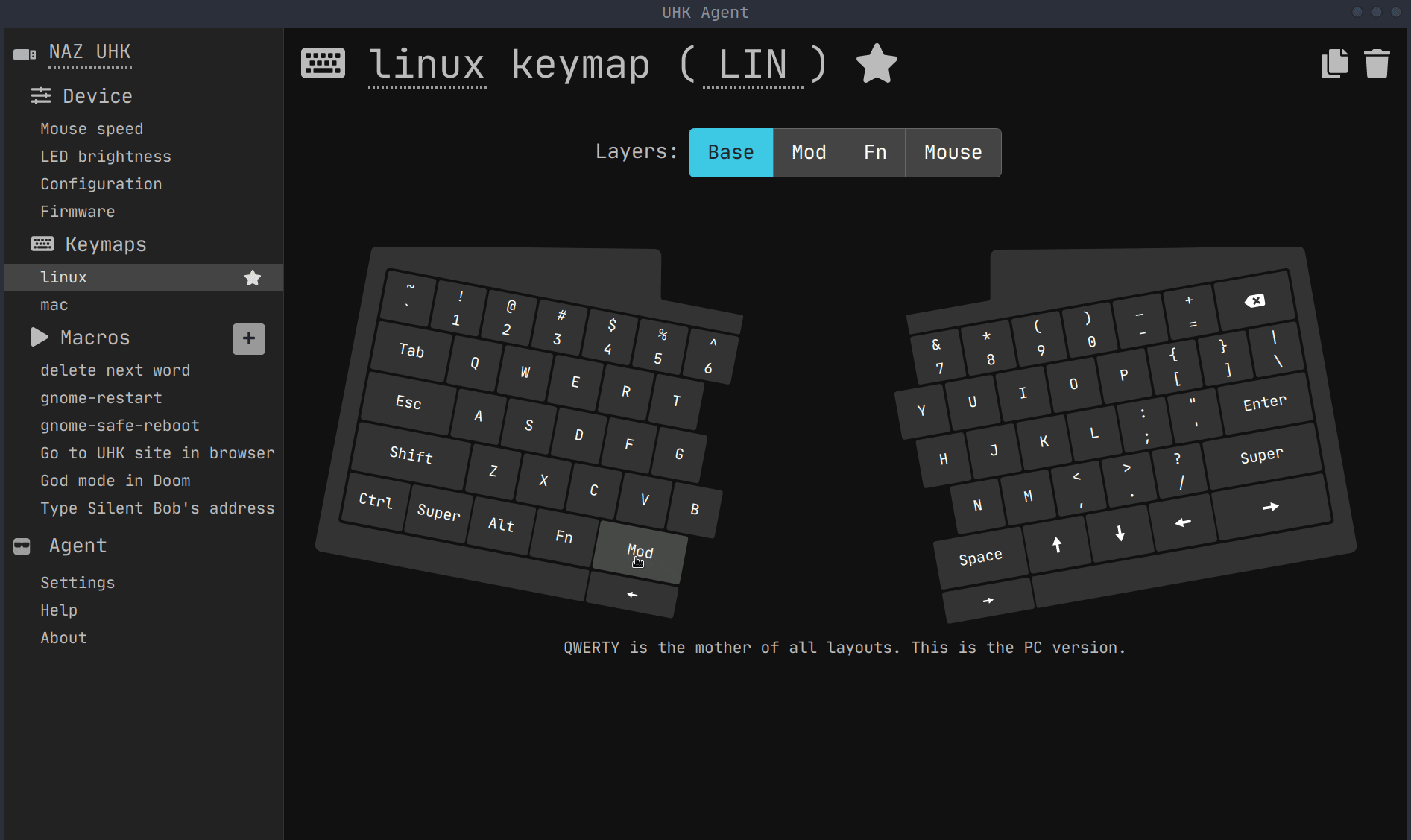
Cons Nits #
I only have nits against this keyboard. Not really cons. The first is that I really miss not having dedicated cursor keys and a row of Page Up, Page Down, Home, and End keys. Yes, I know that you can simply map these keys to another layer like Fn or Mod, or just other individual keys (both of which I have done) but these keys are so frequently used in GNOME that it would make sense to have them as dedicated keys. UHK makes modules and they have a module that adds a few keys (that I have on order) which I hope will address this shortcoming.
Remapping keys and configuring keyboards #
The UHK is so configurable that outside of being happy with the build quality, I really had to think through how I was going to customize the keyboard to suit my programming needs. I did ask for the ultimately configurable keyboard, and I did get just that 😀. Now it is on me to devise strategies to enhance my productivity using this keyboard.
Understanding layers, secondary roles for keys, mouse keys, and macros #
A new concept that comes with this keyboard (when compared to non programmable keyboards) is the ability to not only create your own layers, but also create create secondary roles for keys. You can also control your mouse pointer with the keyboard if you like.
Secondary roles for keys #
Normally we think of a modifier key (like Shift) as something we press and hold down in addition
to pressing another key. However, in the UHK, if you just tap (press once) the modifier key you can
have it type any other key or combination of keys or a macro!
The following table has two examples for the Space key and the Mod key. The Space key behaves
like a normal key, while the Mod key is a modifier key that behaves differently if you just press
it once (launches Alfred), vs hold it down while pressing another key (switches to the Mod layer).
| Key | Tap (press once) | Hold (long press / press with another key) | Notes |
|---|---|---|---|
| Space | Space | Space | Don’t add a secondary role |
| Mod | Alt + Space (launch Albert) | Activate Mod layer (secondary role) | Good example of adding a secondary role |
Taking the example of a key mapped to “Space” you can only just have one function. If you touch the key once you expect it to add a space. If you hold it down, you expect it to type many spaces. So this key is a poor candidate to have any secondary role assigned to it for the following reasons.
- If you assign a modifier key to its secondary role, then you will lose the ability to hold it down and have it type a bunch of spaces; it will just wait for you to type another key.
- And if you don’t type another key and release the “Space” key, then it will type just one space.
Here’s another example of secondary roles using both the Shift keys on the keyboard. I press
backtick and tilde quite a bit (when editing markdown or when using the terminal to switch folders).
The backtick key is on the top left corner of the keyboard making it quite unergonomic to reach. So
I devised the following keymap to make things ergonomic.
| Key | Tap (press once) | Hold (long press / press with another key) |
|---|---|---|
| Left Shift | Left Shift | 🚫 |
| Right Shift | Type Backtick | Left Shift (secondary role) |
| Both Left and Right Shift | Type Tilde | 🚫 |
Layers, mouse keys, and macros #
Not only can you create your own layers, you can also have some layer switching keys lock (rather than just shift into a layer and back out again when all the keys are released). You can also activate the mouse pointer in its own mouse layer, or you can just assign these mouse control functions to any keys in any layer.
One thing that I do is map Fn+O to scroll the mouse down, and Fn+P to scroll the mouse up. I
also had to create a macro in order to move the mouse pointer to the center of whatever window that
is currently focused. When activated, a macro simply generates a sequence of key events, with delays
if you need them. So for me to move my mouse pointer to the center of whatever window has focus, I
have to press Alt+F7 (GNOME shortcut to move a window), and then press Enter. So I created a
macro for this, and mapped it to the Fn layer for the M key.
| Key | Tap (press once) |
|---|---|
| Fn+O | Mouse scroll up |
| Fn+P | Mouse scroll down |
| Fn+M | Move cursor to center of window with focus via macro |
Switching entire keymaps #
UHK also supports the ability to have many keyboard layouts (each one has a base, Mod, Fn, and
Mouse layer). This is good for situations where you want to have quite different keymaps for
different operating systems. So you might have a Linux keymap, and a macOS one, and then switch back
and forth between them, much like you do with layers.
Summary #
Put all this together and you can make some incredibly powerful keyboard shortcuts that you simply can’t do with a “normal” keyboard. However, it isn’t easy to get this “right” and here are some caveats (make sure to test your changes):
- While you might come up with something really useful, without testing it with yourself, it isn’t really possible to know whether this is something that will make you more productive, or just get in your way.
- If you have extensive prior experience with touch typing on normal keyboards, it will be difficult to break old habits and form new ones.
- There are some use cases for which it is best to think about not having one half of the keyboard. For example if you wanted to pan around in Figma you will need to press the space key and drag the mouse. If you space key is on the right half of the keyboard, and you use the mouse w/ your right hand, then this is problematic. So there are situations where you can’t assume that both hands will be on the keyboard halves.
Don’t worry, UHK Agent makes it really easy to switch to older versions of keymaps in case something goes horribly wrong. And you can export specific configurations as well from Agent as a JSON file.
Hierarchy of needs (know your hands) #
The most important thing to keep in mind is understand your hands and how they move. Every time you have to move your hands to reach for the mouse, that slows you down, probably reduces your accuracy for a moment while you readjust your hand position, and it also will end up causing fatigue.
So it is really important for you to know beforehand what are the most common keys and key
combinations that you are typing in your daily workflow. This will really drive the keymaps that you
end up with. For me, it was really important to move the Backspace and Tilde keys away from the top
edges of the keyboard down to the very bottom closest to my thumbs. I also try to use 4 keys on the
bottom center of the keyboard as much as possible for commonly used things like switching
workspaces, switching focus between windows (Alt+Tab). But I have my cursor keys on a Mod layer,
and I really had to practice this for many weeks before it started feeling natural.
When you make big changes to the way you use your keyboard, try and make one big change at a time.
- It is incredibly demoralizing to have a keyboard that you simply can’t use. So make one big
change, like moving all the cursor keys to the
Modlayer and practice to get that to be natural, before making some other massive change - like moving theEnterkey orBackspacekey. - So your keymaps will evolve over time and its best not to have the expectation that you will be able to nail this on your first try.
- And you will end up changing keyboard shortcuts in your favorite apps (if they allow this) in addition to the keyboard keymaps themselves.
So I broke it down into a few major categories, which are either just individual apps that I use or just tasks that can be clumped together. And this is what I came up with (the most important stuff is on top):
- Coding
- JetBrains IDEA based IDEs
- Sublime Text 3
- System level things
- Terminal (Tilix)
- Albert
- CopyQ
- GNOME workspace control
- GNOME tiling window extension control
- Browsers (tab management)
- App specific
- Figma
- Google Sheets
You can actually put all the apps and keyboard shortcuts that you need in a spreadsheet to figure out how to see everything in one place. Here’s an example of that.
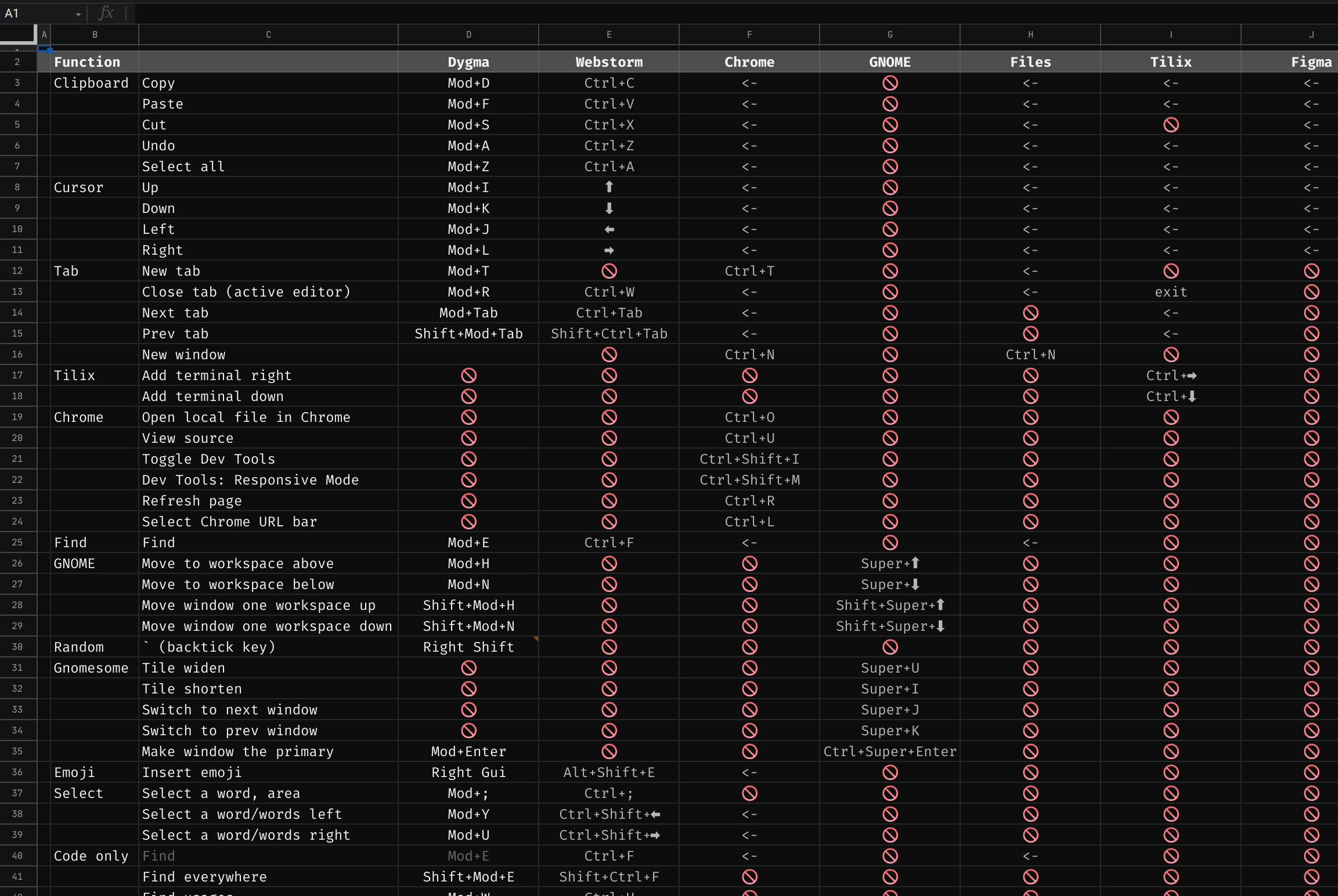
You can download this spreadsheet here as an XLSX file.
Don’t shoot self in foot #
Some historical context is in order. I used to code on laptops, and Kinesis keyboards on desktops, and neither are really programmable. So in order to keep from using the cursor key cluster (Up, Down, Left, Right) on the bottom right of the keyboard, I had developed my own crazy shortcuts in Sublime Text and IDEA so that I would not have to move my hands when I wanted to navigate around in code, UIs, etc.
Also I had to accommodate using macOS as well as Linux, and macOS is terrible about keyboard
customization (I still don’t understand how Meta, Ctrl, Alt don’t always work). This led to some
gnarly key combinations (like Alt + ; for left, and Alt + ' for right, etc). This also required
some heavy customizations to both products, which was very time consuming and difficult to keep in
sync (between apps and across OSes).
After I got the UHK, I have systematically removed these “overly complex” and “custom” workarounds and replaced them w/ the defaults, along with moving any major customizations into the UHK itself. And I just accept that there are limits to typing using a Drop Alt keyboard or a laptop keyboard, and don’t use them for heavy editing sessions. They are mostly for reading and research type tasks.
These are the insights that I gained to making this work effectively and simply using IDEA and Sublime Text as examples.
- Don’t create UHK keymaps for keys that you don’t really need. Eg: there’s no need to make a keymap
for
Ctrl + Yin IDEA. - Keep the keyboard shortcuts as close to the defaults as possible. Eg: there is no need to change
what
Ctrl + Downdoes in either Sublime or IDEA. - If not then, pick a shortcut (and add it to IDEA and Sublime) that is consistent between the two
apps. Here are some examples:
- Add
Ctrl + Shift + Pin IDEA to open Settings (this is a Sublime shortcut that is created for IDEA). - Cloning the caret, and clone selection in both IDEA and Sublime mapped to
Ctrl + JandAlt + Jrespectively. - Expand selection is
Ctrl + Win both.
- Add
- When modifying IDEA keymaps, and Sublime Text key bindings, make sure that each action works well
with other modifier keys. A great example in IDEA is
Ctrl + Down, and its usage withShift,Alt, andShift + Alt, etc.
By following these steps first, there are 2 advantages:
- The UHK mapping can be minimal, so it makes it easy to use UHK Agent to create these in the first place, and to have multiple keymaps for various OSes (you can have a macOS specific keymap, Linux specific one, and Windows specific one).
- These mappings will just work on other keyboards (eg: Drop Alt series).
Examples for UHK keymap #
Here are a list of files you can download.
This is a visual representation of what these keymaps look like.
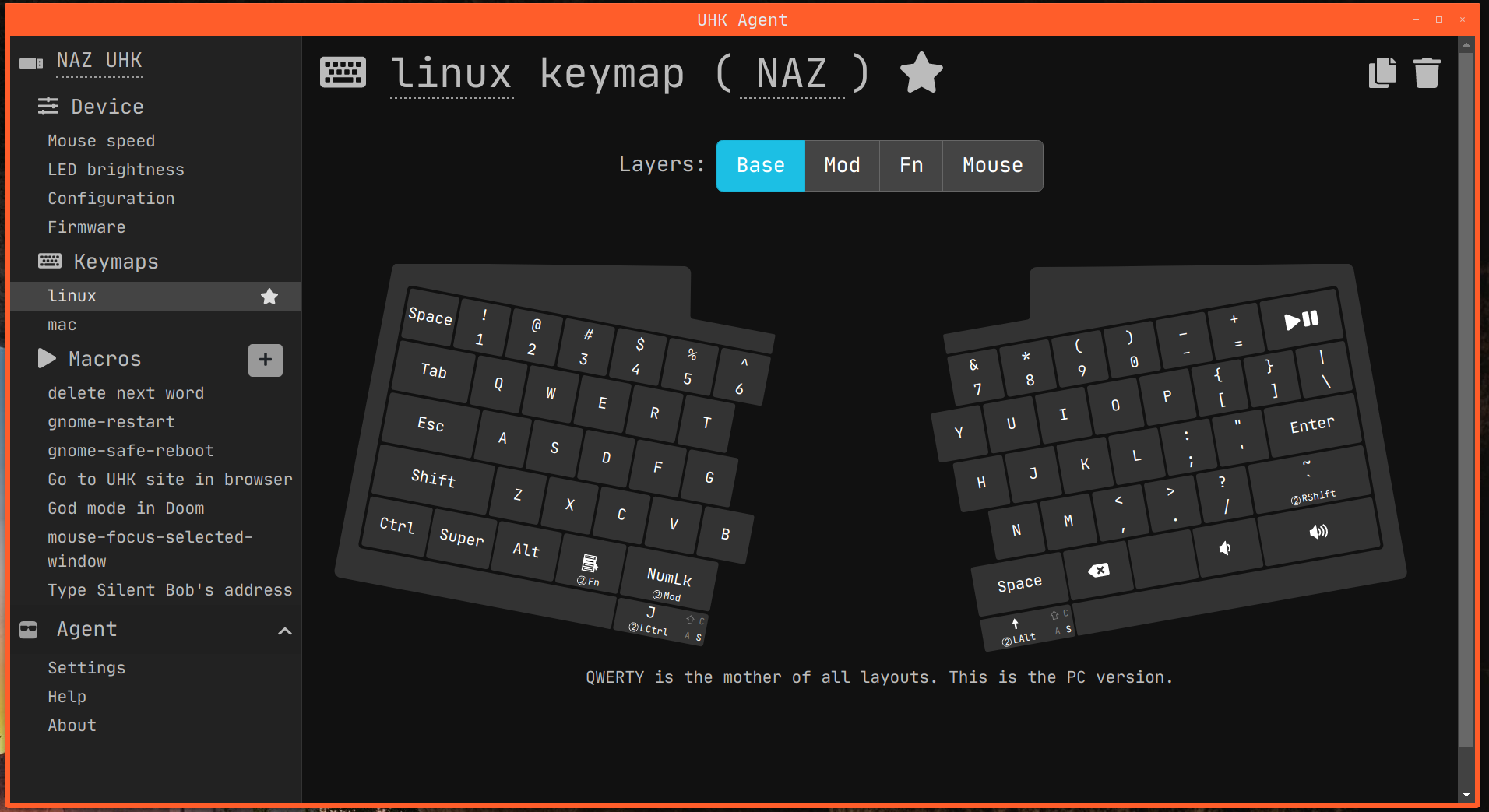
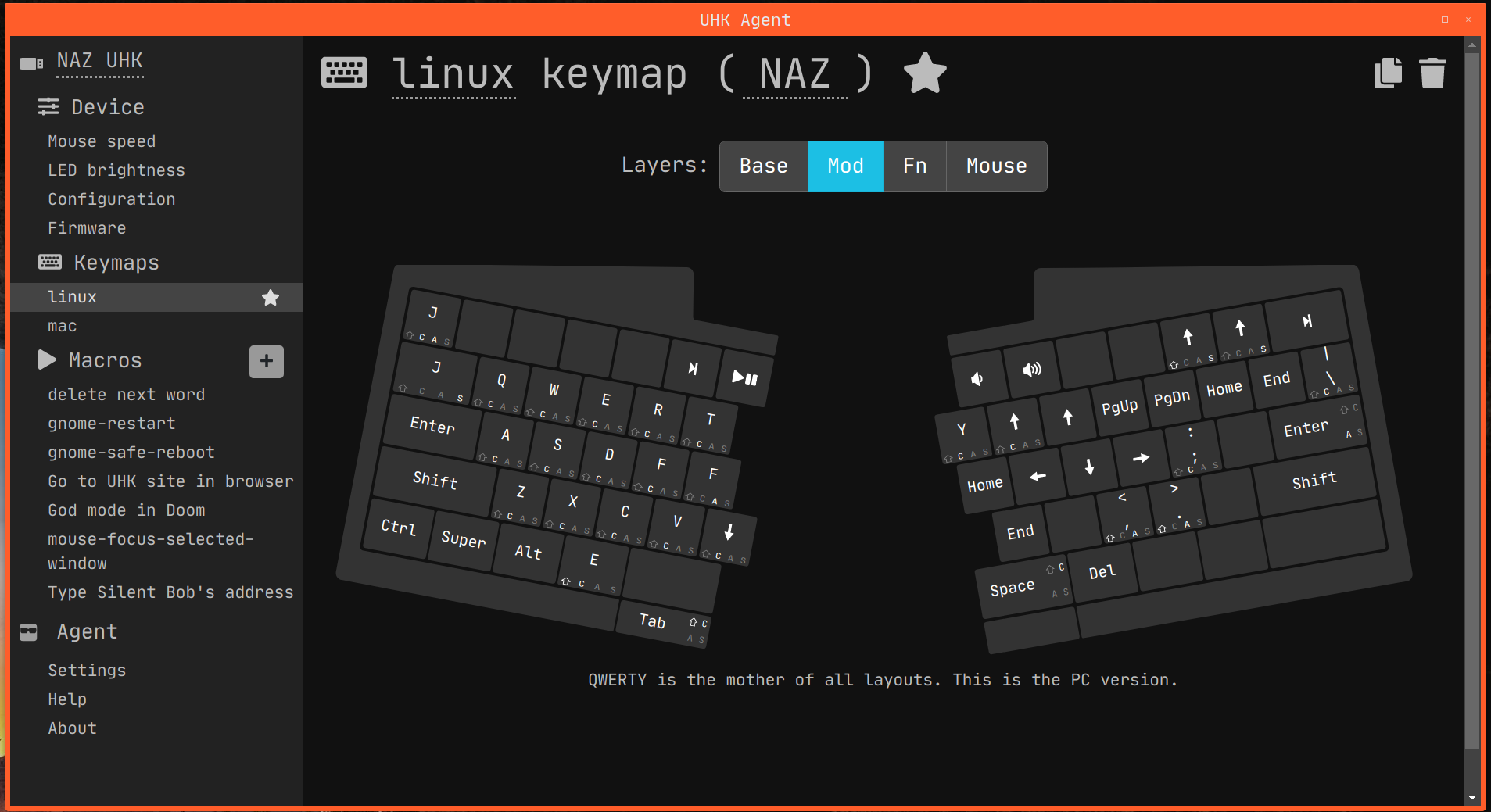
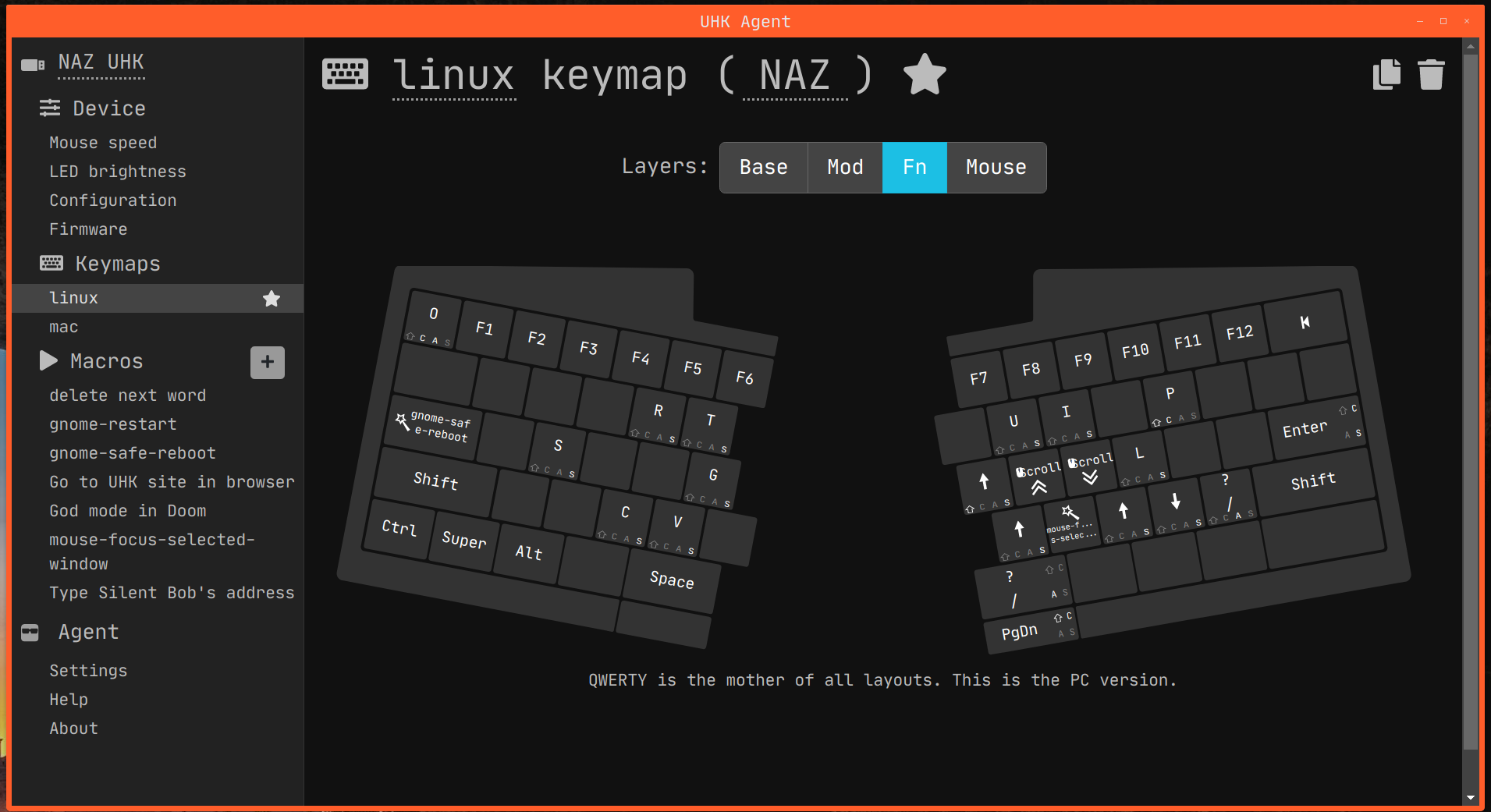
Cursor control #
- Mod + J : Left
- Mod + K : Down
- Mod + L : Right
- Mod + I : Up
- Mod + H : Home
- Mod + ; : End
- Mod + O : Page up
- Mod + P : Page down
- Mod + H : Home
- Mod + J : End
- RightFn : Backspace
- Mod + RightFn : Delete
Mouse control #
- Fn + O : Mouse scroll up
- Fn + P : Mouse scroll down
- Fn + M : Macro to center mouse on currently focused window
- Fn + I : Mouse up
- Fn + J : Mouse left
- Fn + K : Mouse down
- Fn + L : Mouse right
- Fn + ; : Mouse click
GNOME workspace control (with window tiling extension) #
- HiddenKeyLeft : Super + J (like alt-tab)
- Secondary role : Ctrl
- Bonus - Press with Shift to move windows around
- HiddenKeyRight : Move workspace next
- Secondary role : Alt
- Bonus - Press with shift to do all this on workspace previous
- Mod + Tab : Super + J (works w/ GNOME window tiling extension)
- Add Shift and you can actually move the windows rather than switch focus!
- Super + Up, Super + Shift + Up : Move workspace previous and next
- Add Alt to move a window to the prev or next workspace
IDEA and Sublime Text 3 #
- Space
- Mod + Space : code complete (Ctrl+Space)
- Fn + Space : Alt + /
- Enter
- Mod + Enter : Alt + Enter
- Fn + Enter : Ctrl + Enter
- Mod + B : code navigation (go to declaration, jump to source)
- Maps to Ctrl + Down, which works in both IDEA and Sublime.
- Shift+Mod + B : code navigation (go to implementation in IDEA)
- Mod + U : code navigation (back)
- Maps to Ctrl + Up, which works in both IDEA and Sublime.
- Mod + Y : show structure
- In IDEA this maps to Ctrl + Y
- In Sublime Text this maps to Ctrl + R
- Alt + left, Alt + right : tab navigation (move tab to next / prev)
- Mod + HiddenKeyLeft, Mod + HiddenKeyRight : tab navigation (switch to tab next / prev)
- Mod + <, Mod + > : move current tab to the left / right
- Ctrl+Shift + P : Settings…
- Mod + F : find usages in files
- Mod + R : run config
- Mod + D, Mod + S : shift + shift
- Mod + H : Home
- Mod + N : End
- Mod + Esc : Reformat code
- Fn + Esc : Optimize imports
Clipboard history, emoji, albert/alfred #
- Mod (single touch) : Albert
- Mod (long press / secondary role) : Activate Mod layer
- Fn (single touch) : CopyQ
- Fn (long press / secondary role) : Activate Fn layer
- Mod + Fn : emoji picker
- Mod + C : copy
- Mod + V : paste
- Mod + X : delete line (cut)
- Mod + Z : undo
Browser tab management #
- Mod + HiddenKeyLeft, Mod + HiddenKeyRight : switch to next / prev tab
- These simply type
Ctrl + TabandCtrl + Shift + Tabrespectively - gnome issue fix for terminal
- These simply type
- Fn + HiddenKeyLeft, Mod + HiddenKeyRight : move current tab to next / prev
- These simply type
Ctrl + Shift + Page UpandCtrl + Shift + Page Down
- These simply type
Function keys #
- Fn + ~ : toggle between MAC and LIN keymaps
- Fn + 1-0, -, + : F1 - F12
- Fn + Del : Insert
Gnome lockups #
- Fn + Esc : Run the macro
gnome-safe-reboot, which types “Alt + SysRq”, then types “REISUB”
Figma, LucidSpark #
- Fn + Esc : Space (While Space is pressed, dragging the mouse allows panning to happen in many graphical apps)
Ergonomic mechanical keyboard - Mistel BAROCCO MD770 #
My review of this keyboard is very short compared to the UHK v1 😀. The Mistel BAROCCO MD770 has some similarities to the UHK - it is a split ergonomic keyboard with mechanical switches. And it has major differences - it is a 75% layout keyboard when compared to the UHK’s 60%, and it has RGB lighting, but is is not really very configurable.
The build quality is excellent. I ordered one w/ the MX Brown keys, and they feel great to type on. I think for the money this is the highest quality keyboard at its price point. Even though the chassis is light, nothing rattles or is loose. It actually feels like a much heavier and solid construction keyboard.
The connector is USB-C which is great. Just like the Drop Alt Captain, it has a convenient USB-C port on the keyboard itself which makes it great to add another peripheral to (Bluetooth mouse dongle) or a YubiKey.
The customization ability of this keyboard is extremely limited and you have to make the changes on, and there’s no software like Agent to make this easier. You can’t change any key maps in the default layer, but you can press a sequence of keys on the keyboard to map one key to another in four other layers. This nothing like UHK’s Agent, or even the QMK software used by Drop Alt Captain.
You can download the MD770 User Manual PDF from this support page. The PDF has information on how to program the keyboard.
The backlight is very weak. It is just not very good. I almost wish it didn’t come with this feature. The Drop Alt Captain wins hands down in a light show competition! However this keyboard is roughly half the price of the Captain.
Non-ergonomic mechanical keyboard - Drop Alt Captain #
This is also a very short review compared to the UHK v1. The Drop Alt Captain is a totally different category of product when compared to the UHK.
The Captain keyboard has phenomenal build quality, it weighs in at almost 3 lbs! It has amazing RGB lighting. It looks like art more than it does a utilitarian device. The keys feel amazing to type on.
The connector is USB-C which is great. And it has a convenient USB-C port on the keyboard itself which makes it great to add another peripheral to (Bluetooth mouse dongle) or a YubiKey.
The customization is limited, since it uses the QMK software to configure keyboard shortcuts and then flash them on to the keyboard. This software is nowhere near as easy to use as the UHK Agent. Nor is it anywhere nearly as powerful.
It is not an ergonomic keyboard which for me means that I don’t really type on it for any extended period of time. It is more of a toy or a keyboard for a machine that I might use occasionally or even to have as a backup keyboard.
👀 Watch Rust 🦀 live coding videos on our YouTube Channel.
📦 Install our useful Rust command line apps usingcargo install r3bl-cmdr(they are from the r3bl-open-core project):
- 🐱
giti: run interactive git commands with confidence in your terminal- 🦜
edi: edit Markdown with style in your terminalgiti in action
edi in action
